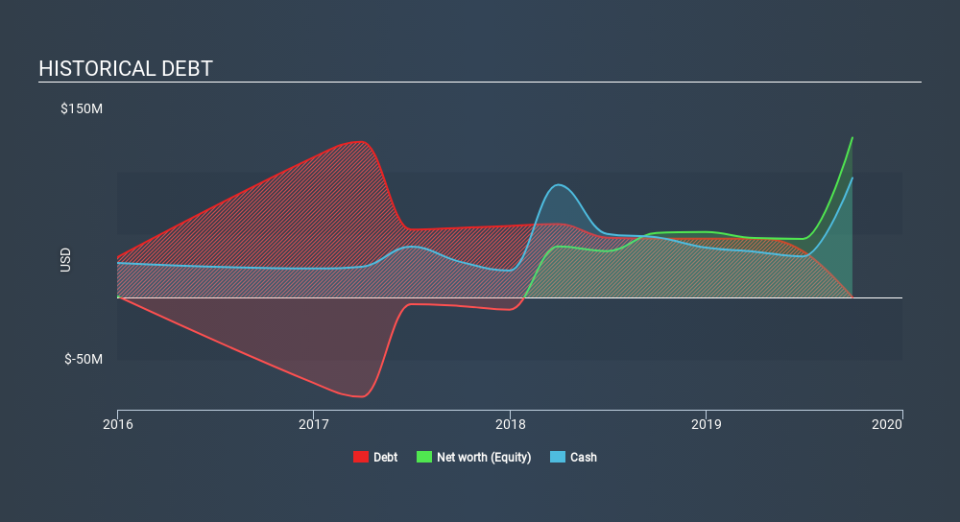Companies Like Cardlytics (NASDAQ:CDLX) Can Afford To Invest In Growth

We can readily understand why investors are attracted to unprofitable companies. For example, Cardlytics (NASDAQ:CDLX) shareholders have done very well over the last year, with the share price soaring by 413%. Nonetheless, only a fool would ignore the risk that a loss making company burns through its cash too quickly.
In light of its strong share price run, we think now is a good time to investigate how risky Cardlytics's cash burn is. In this article, we define cash burn as its annual (negative) free cash flow, which is the amount of money a company spends each year to fund its growth. The first step is to compare its cash burn with its cash reserves, to give us its 'cash runway'.
View our latest analysis for Cardlytics
Does Cardlytics Have A Long Cash Runway?
A company's cash runway is calculated by dividing its cash hoard by its cash burn. When Cardlytics last reported its balance sheet in September 2019, it had zero debt and cash worth US$95m. Importantly, its cash burn was US$6.9m over the trailing twelve months. That means it had a cash runway of very many years as of September 2019. Notably, however, analysts think that Cardlytics will break even (at a free cash flow level) before then. In that case, it may never reach the end of its cash runway. Depicted below, you can see how its cash holdings have changed over time.
How Well Is Cardlytics Growing?
Cardlytics managed to reduce its cash burn by 72% over the last twelve months, which suggests it's on the right flight path. Pleasingly, this was achieved with the help of a 33% boost to revenue. We think it is growing rather well, upon reflection. Clearly, however, the crucial factor is whether the company will grow its business going forward. So you might want to take a peek at how much the company is expected to grow in the next few years.
How Easily Can Cardlytics Raise Cash?
While Cardlytics seems to be in a decent position, we reckon it is still worth thinking about how easily it could raise more cash, if that proved desirable. Generally speaking, a listed business can raise new cash through issuing shares or taking on debt. Commonly, a business will sell new shares in itself to raise cash to drive growth. By comparing a company's annual cash burn to its total market capitalisation, we can estimate roughly how many shares it would have to issue in order to run the company for another year (at the same burn rate).
Cardlytics's cash burn of US$6.9m is about 0.4% of its US$1.8b market capitalisation. So it could almost certainly just borrow a little to fund another year's growth, or else easily raise the cash by issuing a few shares.
Is Cardlytics's Cash Burn A Worry?
It may already be apparent to you that we're relatively comfortable with the way Cardlytics is burning through its cash. In particular, we think its cash runway stands out as evidence that the company is well on top of its spending. And even its revenue growth was very encouraging. Shareholders can take heart from the fact that analysts are forecasting it will reach breakeven. After considering a range of factors in this article, we're pretty relaxed about its cash burn, since the company seems to be in a good position to continue to fund its growth. When you don't have traditional metrics like earnings per share and free cash flow to value a company, many are extra motivated to consider qualitative factors such as whether insiders are buying or selling shares. Please Note: Cardlytics insiders have been trading shares, according to our data. Click here to check whether insiders have been buying or selling.
Of course, you might find a fantastic investment by looking elsewhere. So take a peek at this free list of interesting companies, and this list of stocks growth stocks (according to analyst forecasts)
If you spot an error that warrants correction, please contact the editor at editorial-team@simplywallst.com. This article by Simply Wall St is general in nature. It does not constitute a recommendation to buy or sell any stock, and does not take account of your objectives, or your financial situation. Simply Wall St has no position in the stocks mentioned.
We aim to bring you long-term focused research analysis driven by fundamental data. Note that our analysis may not factor in the latest price-sensitive company announcements or qualitative material. Thank you for reading.

